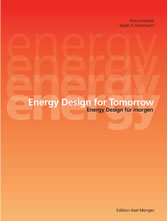Suchen und Finden
Service
Energy Design for Tomorrow. Energie Design für morgen
Klaus Daniels, Ralph Hammann
Verlag Edition Axel Menges, 2009
ISBN 9783936681253 , 368 Seiten
Format PDF
Kopierschutz DRM
1 The greenhouse effect (p. 18-19)
The problem of the future availability of fossil fuels is currently being overshadowed by the discussion of how their use may contribute to global climate change. In this discussion, two opposing camps of scientists and climate researchers come to very different conclusions. One group, led by the Intergovernmental Panel on Climate Change (IPCC), is convinced that climate change is a result of a rise in carbon dioxide levels in the atmosphere, while another group of scientits disputes this view and suggests that climate change is a natural-occurring process as a result of increased solar activity.
The authors of this book are reluctant to position themselves on the side of either of those camps because they are not climate scientists and thus are unable to fully fathom the complex causalities of the issue.
As a result, the authors will present both positions equally weighted.
The fact that the concentration of carbon dioxide gas in the atmosphere, which was at around 280 ppm in the year 1800, has increased to levels of around 350 ppm today cannot be disputed. The increase of the surface temperature of the Earth is currently approximately 0.8 K (Kelvin).
Historically, times of colder temperatures on earth have always given way to periods of warmer temperatures without a clear association to CO2 levels. Calculations made by the Niels Bohr Institute of Copenhagen allow the conclusion that sudden temperature increases of 7 – 10 K every 1,500 years are natural chaotic fluctuations of the climate system. What also can be derived from these studies is that so far no correlation exists between rising CO2 levels and the global temperature increase.
The analysis of ice cores drilled deep into glaciers has revealed a cycle of glacials and interglacials that have occurred throughout Earth`s history. Currently, we are in a warm period of an ice age, as seen at glaciers at least on one of the Earth’s poles. Warm periods are typically brief periods in a glacial period. Between 8000 and 6000 B.C., temperatures in the northern hemisphere were significantly warmer than they are today, but at the same time the CO2 concentration in the atmosphere passed through a minimum of around 260 ppm. When this level started to rise in the centuries that followed – without human intervention – the temperature, interestingly, started to decrease.
Around the time of the birth of Jesus of Nazareth, a brief warm period was observed, as documented in the records of Roman military campaigns. Around 400 years later, mass migration from the North to the South of Europe began in response to the beginning cold period that lasted around 500 years, until about 800 A.D. Approximately 200 years later, Norwegians settled and cultivated parts of Greenland and North America. Then, in 1300, another cold period began that resulted, between approximately 1500 and 1700, in extremely low temperatures in Central Europe, with summer highs not greater than 15 ºC. Although the temperature in these periods changed dramatically from year to year, CO2 levels remained nearly constant. Any increase in global temperatures at the time was prevented by the eruption of the Laki volcano in Iceland in 1783, which ejected several hundred million tons of dust and gas into the atmosphere.



